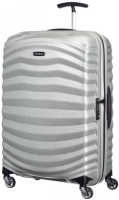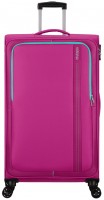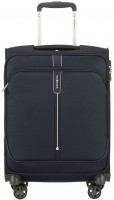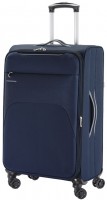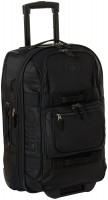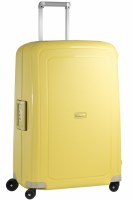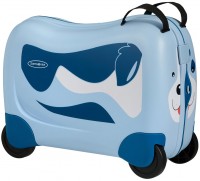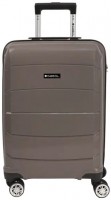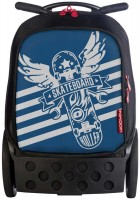Luggage Samsonite
All Luggage Advanced filters → |
You might be interested in
Luggage: specifications, types
Type
— Suitcase. In this case, classic suitcases are products that are poorly adapted for carrying in hands and designed primarily for transportation on wheels. One of their key differences from bags is the location of the carrying handle. It is installed on the top or side end (if you look at the suitcase, placed vertically on the wheels) and is intended not so much for constant carrying, but for a short-term "jump" in places where the wheels cannot pass — on stairs, exits from vehicles or from escalators , uneven pavement, etc.
— Backpack. True to the name, this type of suitcase is well suited for carrying on straps behind the back. And outwardly, such products are very similar to traditional backpacks — in particular, they have a characteristic appearance and layout, fabric is used as the body material (see below). At the same time, all this is combined with "suitcase" functions, primarily a handle and wheels.
— Case-pilot. Such products are relatively small, horizontally arranged, and may resemble suitcases or small universal bags (like those used, in particular, for laptops). In addition, unlike classic travel suitcases, they are usually equipped with a pair of full-fledged handles, and often with a shoulder strap, due to which they are well suited for long-term carrying in hands. At the same time, such models also provide a retractable handle and wheels, which allows you to carry the pilo...t case “in a suitcase”.
— Backpack. True to the name, this type of suitcase is well suited for carrying on straps behind the back. And outwardly, such products are very similar to traditional backpacks — in particular, they have a characteristic appearance and layout, fabric is used as the body material (see below). At the same time, all this is combined with "suitcase" functions, primarily a handle and wheels.
— Case-pilot. Such products are relatively small, horizontally arranged, and may resemble suitcases or small universal bags (like those used, in particular, for laptops). In addition, unlike classic travel suitcases, they are usually equipped with a pair of full-fledged handles, and often with a shoulder strap, due to which they are well suited for long-term carrying in hands. At the same time, such models also provide a retractable handle and wheels, which allows you to carry the pilo...t case “in a suitcase”.
Closure type
- With a zipper. A classic zipper on three or four sides of the suitcase securely holds the lid and prevents it from opening. A combination lock can often be inserted into zipper pulls to protect the contents from unauthorized persons. Also, suitcases with this type of closure often have an additional rubberized edging, which will come in handy in case of bad weather. It prevents water from entering the suitcase through the most vulnerable spot - the zipper seams, allowing things to remain dry even in heavy rain.
- On latches. The latched design of the suitcase is highly rigid and airtight, making it a good option for transporting fragile items. Such suitcases are usually made of plastic and equipped with three or four clips. The edges of the suitcase are edged with dense rubber material; when closed, the two sides are pressed against each other so tightly that they do not allow moisture or even air to pass through. A combination lock is often placed on one of the latches.
- On latches. The latched design of the suitcase is highly rigid and airtight, making it a good option for transporting fragile items. Such suitcases are usually made of plastic and equipped with three or four clips. The edges of the suitcase are edged with dense rubber material; when closed, the two sides are pressed against each other so tightly that they do not allow moisture or even air to pass through. A combination lock is often placed on one of the latches.
Capacity
The total volume of the suitcase in liters. On the one hand, the number of things that can be placed inside depends on this parameter, and on the other hand, the dimensions and weight of the suitcase itself. The optimal balance between these characteristics depends on the number of people for which the product is designed, as well as on the characteristics of the planned trips.
Conventionally, suitcases can be divided into 3 categories: small(up to 30 L), medium(up to 70 L), large(up to 100 L) and huge(over 100 L). The first option is well suited for those who are going to travel alone, and the duration of trips is not very long. Also in this category are children's suitcases, which are distinguished by a catchy design, compact size and special appearance. Medium models are suitable for two people (or, again, for one — with a long journey). And the largest suitcases can be called "family".
Also note that some models may have adjustable dimensions and, accordingly, adjust to the volume; for such suitcases, the maximum volume is indicated in the characteristics — in a fully unfolded state.
Conventionally, suitcases can be divided into 3 categories: small(up to 30 L), medium(up to 70 L), large(up to 100 L) and huge(over 100 L). The first option is well suited for those who are going to travel alone, and the duration of trips is not very long. Also in this category are children's suitcases, which are distinguished by a catchy design, compact size and special appearance. Medium models are suitable for two people (or, again, for one — with a long journey). And the largest suitcases can be called "family".
Also note that some models may have adjustable dimensions and, accordingly, adjust to the volume; for such suitcases, the maximum volume is indicated in the characteristics — in a fully unfolded state.
Capacity change
The ability to increase / decrease the volume of the suitcase. It is mainly provided by unzipping the zipper around the perimeter of the suitcase. Thanks to the function of changing the volume, the capacity can be increased, and if not needed, reduced.
Dimensions (HxWxD)
Dimensions of the suitcase in height, width and depth (it is assumed that the product stands vertically on wheels). For products with volume adjustment, the unfolded dimensions are usually indicated.
It is worth noting that with the same volume, different models may have different sizes; knowing these numbers, you can to some extent evaluate the features of the suitcase and choose the necessary model of hand luggage on the plane. For example, a large width provides stability when transported on wheels, but is not very convenient when transported on a train — the suitcase may not “fit” under the shelf on the side; wide bags (see "Type") are also less convenient to carry by the handle on the front side, etc.
It is worth noting that with the same volume, different models may have different sizes; knowing these numbers, you can to some extent evaluate the features of the suitcase and choose the necessary model of hand luggage on the plane. For example, a large width provides stability when transported on wheels, but is not very convenient when transported on a train — the suitcase may not “fit” under the shelf on the side; wide bags (see "Type") are also less convenient to carry by the handle on the front side, etc.
Weight
The weight of the empty suitcase. The lower this value, the easier it will be to transport luggage (with the same weight of things placed inside). On the other hand, lightweight suitcases usually have a less dense body material. Therefore, it is worth choosing a model by weight, taking into account what balance between strength and lightness will be optimal for you.
Number of external pockets
The presence of pockets in the suitcase allows you to sort small things so as not to search all over the suitcase. External pockets allow you to provide quick access to them. Among those, there can be both small ones for keys, passports, and larger ones where you can put documents, change of clothes.
Number of internal pockets
Internal pockets allow you to sort small things from the general luggage. Mostly made with mesh, which additionally allows you to see what is in your pocket and quickly get access to the necessary "little things".
Number of wheels
The number of wheels for transportation on the ground, provided in the design of the suitcase. The simplest option provides two wheels — this allows you to roll the product only in an inclined position, and for vertical installation, two additional supports are provided on the lower end. There are also models with 4 wheels — they can be moved without tilting, and the wheels themselves are usually made 360 ° swivel (self-orienting). This design is especially convenient in situations where the weight of the suitcase is large, and you have to move it over short distances — for example, in line for check-in at the airport. At the same time, these models are somewhat more expensive than two-wheeled ones.
Material
— Fabric. Most often in suitcases, this term refers to various synthetic materials, in particular nylon or polyester. Depending on the density (see below), the properties of the fabric can vary noticeably - from a soft, easily wrinkled shell, which provides practically no protection from impacts, to dense and thick “armor”, comparable in degree of protection to thin plastic (although for particularly fragile things, all It is equally better to use products made from solid materials). In any case, the fabric is quite inexpensive, often has a water-resistant impregnation, and sometimes other special “chips” - for example, the Rip-Stop system, which, in the event of a tear, prevents the hole from enlarging. Also, in the design of such suitcases it is much easier to provide additional pockets (especially external ones) than in plastic( ABS plastic, polycarbonate, polypropylene) or metal ones. Due to this, the fabric became widespread.
- Plastic. Plastic is light weight and low cost; at the same time, due to its hardness, it protects fragile contents much better from various impacts and loads than fabric. True, the strength of this material can vary - there are many types of plastic that differ in characteristics and, accordingly, price. So ABS plastic is hard due to i...ts heavy weight, but unreliable. It may crack if hit hard and is not suitable for sub-zero temperatures. The void during filling is critical and can lead to deformation under load. But ABS plastic is the cheapest and brightest (available in any colors and patterns). Polycarbonate is characterized by UV resistance, increased strength, impact resistance and heat resistance. It is like an average link among plastic models. And polypropylene, which rises above other types of plastic due to its resistance to mechanical damage. It is practically not subject to corrosion cracking and is impact resistant. And its flexibility allows it to be used not fully loaded and even empty. After all, having sagged under the weight of another suitcase, polypropylene will self-restore its shape.
- Metal. Metal gives the suitcase a solid appearance, while it combines hardness with high strength, significantly surpassing plastic in both of these characteristics - metal suitcases are considered the most protected. At the same time, the cost of this material is quite high, the weight is also significant, and the mentioned degree of protection is not always required - for most travelers, the possibilities provided by lighter and cheaper plastic products are sufficient. Therefore, this option is not widely used.
- Leather. Genuine leather can be classified as premium materials. It provides a rich and “presentable” appearance, and at the same time costs accordingly - so owning a leather suitcase quite clearly confirms the status of the owner. On the other hand, such models are distinguished by significant weight and require rather troublesome maintenance - otherwise all respectability will be hidden behind cracks and abrasions. So, from a practical point of view, leather is noticeably inferior to fabric and plastic.
- Plastic. Plastic is light weight and low cost; at the same time, due to its hardness, it protects fragile contents much better from various impacts and loads than fabric. True, the strength of this material can vary - there are many types of plastic that differ in characteristics and, accordingly, price. So ABS plastic is hard due to i...ts heavy weight, but unreliable. It may crack if hit hard and is not suitable for sub-zero temperatures. The void during filling is critical and can lead to deformation under load. But ABS plastic is the cheapest and brightest (available in any colors and patterns). Polycarbonate is characterized by UV resistance, increased strength, impact resistance and heat resistance. It is like an average link among plastic models. And polypropylene, which rises above other types of plastic due to its resistance to mechanical damage. It is practically not subject to corrosion cracking and is impact resistant. And its flexibility allows it to be used not fully loaded and even empty. After all, having sagged under the weight of another suitcase, polypropylene will self-restore its shape.
- Metal. Metal gives the suitcase a solid appearance, while it combines hardness with high strength, significantly surpassing plastic in both of these characteristics - metal suitcases are considered the most protected. At the same time, the cost of this material is quite high, the weight is also significant, and the mentioned degree of protection is not always required - for most travelers, the possibilities provided by lighter and cheaper plastic products are sufficient. Therefore, this option is not widely used.
- Leather. Genuine leather can be classified as premium materials. It provides a rich and “presentable” appearance, and at the same time costs accordingly - so owning a leather suitcase quite clearly confirms the status of the owner. On the other hand, such models are distinguished by significant weight and require rather troublesome maintenance - otherwise all respectability will be hidden behind cracks and abrasions. So, from a practical point of view, leather is noticeably inferior to fabric and plastic.
Fabric density
The density of the fabric from which the suitcase is made (see "Case Material"). This parameter is measured in den; 1 den corresponds to such a density at which a thread 9 km long will weigh 1 gram. Accordingly, the higher the density of the fabric — the thicker the threads used for weaving it, the coarser, tougher it is and the higher the degree of protection (although the weight increases accordingly). The minimum value for modern products is 300 den; 420 den can be compared with the material of ordinary "sports and travel" bags, and in the most advanced models this figure can exceed 1000 den.
Laptop compartment
The presence in the design of the suitcase of a special compartment for a laptop. Using this feature is usually more convenient and safer than carrying a laptop along with the rest of your luggage: such compartments are usually equipped with special straps for fixing, their own reinforced frame, additional soft tabs and other means to protect a valuable item. One has only to take into account that the size of the compartments can be different, and a large laptop (for example, 17 ") may not fit in the selected suitcase model. Therefore, when choosing, you should pay attention to compatible laptop sizes; data on this (usually the largest size of the transported device) usually spelled out in the detailed specifications.
Lock
The presence of a lock in the design of the suitcase. It can be either a built-in fixture or an external padlock, hooked onto zipper sliders connected together. This feature makes it much more difficult to access the contents of the suitcase and provides additional security if it falls into the hands of strangers. Of course, the lock will not protect the product from deliberate hacking, but it will become a serious obstacle for those who would like to search the bag quickly and discreetly (for example, unscrupulous porters at the airport).
Note that this item does not cover locks that meet the TSA standard — their availability is indicated separately in our catalog, and the features are described in the corresponding item below.
Note that this item does not cover locks that meet the TSA standard — their availability is indicated separately in our catalog, and the features are described in the corresponding item below.
TSA lock
Compliance of the lock installed in the suitcase (see above) with the TSA standard. TSA is an acronym for Transportation Security Administration, i.e. United States Transportation Safety Administration; it was at the suggestion of this structure that similar castles appeared — after the September 11 attacks. These events led to increased security measures during customs inspection, including more frequent opening of luggage — but without an owner with a key, the lock often had to be broken, rendering the product unusable and causing indignation of passengers.
To remedy the situation, TSA locks were developed. They may differ in design and appearance, be built-in, mounted, etc.; however, all options have two ways of opening and closing — normal and service. The usual one involves the use of a digital code — this is how the owner of the suitcase works with the lock. To open the "service" way, a special key is used that is compatible with all TSA locks; only customs and security officials have such keys. Thanks to this, if necessary, experts can easily and quickly open the suitcase for inspection, and then return it to the owner with a closed and fully functional lock. Some models of locks have an indicator that indicates that it was opened with a service key.
TSA keys are currently used by US, Canadian, UK, and Israeli Customs. So suitcases with such locks are definitely recommended for traveling to these countries; in addit...ion, the list can expand, so before traveling it makes sense to clarify the features of customs inspection at the destination. Do not neglect this nuance: if they decide to inspect your luggage at the entrance, this will be done anyway, and it depends only on the type of lock whether it will be opened with a service key or brute-forced without the possibility of repair.
To remedy the situation, TSA locks were developed. They may differ in design and appearance, be built-in, mounted, etc.; however, all options have two ways of opening and closing — normal and service. The usual one involves the use of a digital code — this is how the owner of the suitcase works with the lock. To open the "service" way, a special key is used that is compatible with all TSA locks; only customs and security officials have such keys. Thanks to this, if necessary, experts can easily and quickly open the suitcase for inspection, and then return it to the owner with a closed and fully functional lock. Some models of locks have an indicator that indicates that it was opened with a service key.
TSA keys are currently used by US, Canadian, UK, and Israeli Customs. So suitcases with such locks are definitely recommended for traveling to these countries; in addit...ion, the list can expand, so before traveling it makes sense to clarify the features of customs inspection at the destination. Do not neglect this nuance: if they decide to inspect your luggage at the entrance, this will be done anyway, and it depends only on the type of lock whether it will be opened with a service key or brute-forced without the possibility of repair.
RFID blocking
The presence of a pocket or compartment with special protection against reading RFID tags. Such tags are used, in particular, in contactless credit cards using PayPass or PayWave technology; in this case, the communication range is several centimeters, and an attacker with a special scanner, getting close, can read credit card data even through the material of the suitcase. RFID protection prevents such troubles: it shields the cards inside the pocket, making them unscannable from the outside.
USB interface
Standard USB connector located on the outside of the product. Allows you to charge smartphones, tablets and other gadgets without opening your suitcase — the main thing is that you have the appropriate cable at hand. Of course, for such charging, you will need a power bank or other source of energy connected to the USB port of the suitcase from the inside; such a source is not included in the scope of supply.
Side handle
The presence of a side handle on the suitcase, which allows you to carry it not in a vertical, but in a horizontal position. This solution appropriately facilitates the transportation of the suitcase, for example, on stairs, on uneven roads (earth, gravel, sand), etc.

